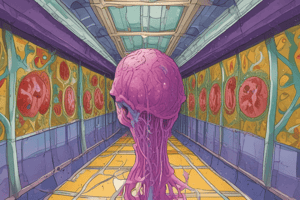Podcast
Questions and Answers
What is hypertrophy?
What is hypertrophy?
Increased size of cells due to increased production of structural proteins and organelles.
What is hyperplasia?
What is hyperplasia?
Controlled proliferation of existing cells, resulting in an increase in cell number.
What is atrophy?
What is atrophy?
Reduced tissue mass due to decreased cell size and/or number.
What is metaplasia?
What is metaplasia?
What is dysplasia?
What is dysplasia?
What characterizes apoptosis?
What characterizes apoptosis?
What triggers the intrinsic pathway of apoptosis?
What triggers the intrinsic pathway of apoptosis?
What happens in the extrinsic pathway of apoptosis?
What happens in the extrinsic pathway of apoptosis?
How does the perforin/granzyme B pathway work?
How does the perforin/granzyme B pathway work?
What occurs during reversible cell injury?
What occurs during reversible cell injury?
Study Notes
Cellular Adaptations
- Hypertrophy is an increase in cell size due to increased production of structural proteins and organelles.
- Example: Myocardial hypertrophy caused by hypertension.
- Hyperplasia is an increase in the number of cells due to controlled proliferation of existing cells.
- Example: Prostatic hyperplasia.
- Can progress to dysplasia.
- Atrophy is a decrease in tissue mass due to decreased cell size and/or number.
- Causes include denervation, loss of blood supply, loss of hormonal stimulation, and aging.
- Metaplasia is the replacement of one cell type with another in response to stressors.
- Example: Replacement of respiratory ciliated columnar epithelium with stratified squamous epithelium due to smoking.
- Can progress to dysplasia.
- Dysplasia is disordered, precancerous epithelial cells characterized by changes in cell orientation, nuclear size, and shape.
- Moderate dysplasia doesn't involve the entire tissue.
- Severe dysplasia often precedes malignancy.
- Usually, persistent metaplasia precedes dysplasia.
Apoptosis
- Programmed cell death that is ATP-dependent.
- Involves intrinsic, extrinsic, and perforin/granzyme B pathways.
- These pathways activate caspases leading to:
- Cell shrinkage
- Chromatin condensation
- Membrane blebbing
- Formation of apoptotic bodies (which are phagocytosed)
- Characterized by:
- Deeply eosinophilic cytoplasm and basophilic nucleus
- Pyknosis (nuclear shrinkage)
- Karyorrhexis (nuclear fragmentation)
- Cell membrane remains intact without significant inflammation.
Intrinsic (Mitochondrial) Pathway
- Involved in tissue remodeling during embryogenesis and when a regulating factor is withdrawn from a proliferating cell population.
- Occurs after exposure to injurious stimuli such as radiation, toxins, or hypoxia.
- Regulated by the Bcl-2 family of proteins:
- BAX and BAK are pro-apoptotic.
- Bcl-2 and Bcl-xL are anti-apoptotic.
- BAX and BAK form pores in the mitochondrial membrane, leading to:
- Release of cytochrome C from the inner mitochondrial membrane into the cytoplasm.
- Activation of caspases.
- Bcl-2 prevents cytochrome C release by maintaining mitochondrial membrane impermeability.
- Overexpression of Bcl-2 is linked to tumorigenesis.
Extrinsic (Death Receptor) Pathway
- Involves ligand-receptor interactions, such as:
- FasL binding to Fas (CD95)
- TNF-α binding to its receptor
- Fas-FasL interaction is crucial for thymic medullary negative selection in immune system development.
- Failure of this interaction can lead to autoimmune lymphoproliferative syndrome:
- Increased self-reacting lymphocytes
- Lymphadenopathy
- Hepatosplenomegaly.
Perforin/Granzyme B Pathway
- Involves the release of granules containing perforin and granzyme B by cytotoxic T cells and natural killer cells.
- Perforin forms a pore in the target cell membrane, allowing granzyme B to enter and activate caspases, leading to apoptosis.
Cell Injury
Reversible Cell Injury
- Decreased ATP: Activity of Ca2+ and Na+/K+ pumps, leading to cellular swelling (cytosol, mitochondria, endoplasmic reticulum/Golgi). This is the earliest morphologic manifestation of most forms of injury.
Studying That Suits You
Use AI to generate personalized quizzes and flashcards to suit your learning preferences.
Description
This quiz explores various cellular adaptations including hypertrophy, hyperplasia, atrophy, metaplasia, and dysplasia. Each concept is illustrated with specific examples, helping to clarify the mechanisms behind these adaptive processes and their significance in pathology. Test your understanding of how these adaptations relate to tissue health and disease.




